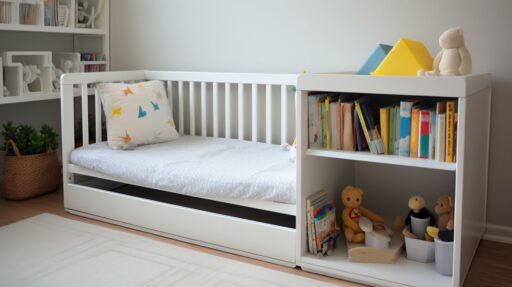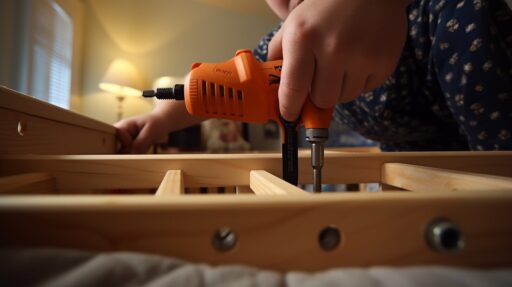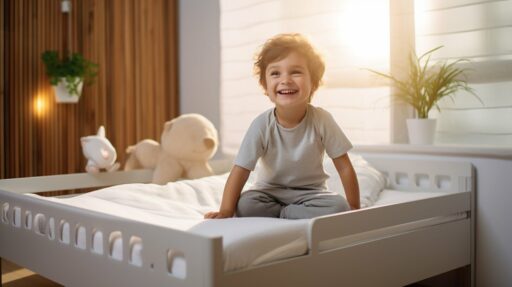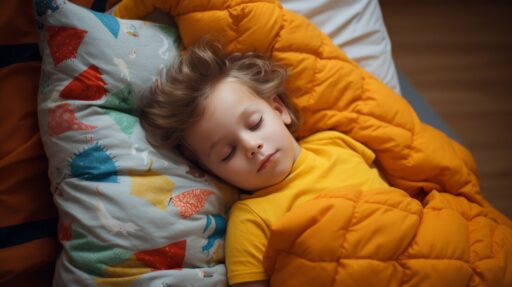
Evolving Children’s Beds for Safe Toddler Transitions
Transitioning from a crib to a toddler bed is a major milestone. Evolving children’s beds ease this shift with safety, comfort, and flexibility—turning a tricky phase into an exciting adventure.
Key Takeaways
- Evolving beds grow with your child, reducing furniture replacement costs
- They enhance safety with guardrails, low profiles, and snug mattress fits
- Encouraging personalization helps toddlers embrace bedtime routines
Making the Big Switch
According to the American Academy of Pediatrics, most children transition from a crib to a bed between 18 months and 3 years old. If your toddler is climbing out, resisting sleep, or asking for more independence, it may be time.
Evolving beds are designed with flexibility in mind. Some begin as cribs and can convert into toddler beds, daybeds, and eventually full-size beds. This means your child stays in a familiar frame throughout early childhood, reducing anxiety and adjusting to their growth without the need for constant new purchases. Parents often share that involving their child in the setup or bedding selection makes the transition exciting rather than scary.
You can also ease the change by placing the evolving bed in the same spot the crib stood and using the same bedding textures or sleep toys. That sense of consistency gives your child confidence. The result? A smoother bedtime routine and less resistance when the lights go out.

Perfect Mattress Fit = Safer Sleep
Safety starts with the mattress—specifically, the way it fits inside the bed frame. A mattress that’s too small or too soft can create dangerous gaps or cause your child to sink, especially if they roll toward the edge. Evolving children’s beds often come with adjustable platforms that align with mattress height as your child grows, eliminating loose fits and uncomfortable setups.
Look for breathable, hypoallergenic materials in your toddler’s mattress to prevent overheating and allergies. Foam mattresses with cooling layers, or hybrid models with innerspring support, are often recommended for toddlers due to their mix of softness and structure. The mattress should be firm enough to support spinal alignment, yet cozy enough to soothe.
Follow safe sleep recommendations from the U.S. Consumer Product Safety Commission to ensure your mattress choice meets current safety standards. You can also learn more in our guide on platform and storage beds.

Safety Comes First
Every parent’s number one concern when it comes to sleep: safety. Evolving children’s beds address this directly with a thoughtful blend of design and engineering. These beds often feature rounded corners to prevent bumps, anti-tip hardware for secure assembly, and reinforced guardrails that can be removed or adjusted as your child grows.
Low-profile frames are a key safety feature for toddlers who might roll or climb out of bed. A bed that’s just 10–12 inches off the ground minimizes fall risk and builds your child’s confidence to get in and out independently. Some evolving beds also include under-bed drawers that lock in place, removing the temptation to crawl underneath.
It’s important to perform regular safety checks—tighten all bolts, test the frame for wobble, and ensure the guardrails are firmly attached. As toddlers grow, they explore more—so their bed needs to handle a bit of climbing, bouncing, and rolling without budging.
By starting with a bed built for safety, you’re not just easing bedtime—you’re creating a secure space where your child feels confident and calm. That’s the first step toward good sleep hygiene and lasting rest habits.

Room Setup and Babyproofing Basics
Room arrangement plays a vital role in both safety and sleep quality. Start by choosing a quiet corner away from windows and high-traffic areas. This helps reduce noise disturbances and limits distractions during bedtime. Make sure the evolving bed is not placed beneath wall-mounted objects like shelves or heavy frames—these could pose hazards if they fall.
For electrical safety, use outlet covers and secure any cords out of reach with cord organizers. If blinds or curtains have pull strings, opt for cordless alternatives or safety tensioners. Nightlights with low-wattage bulbs can make midnight bathroom trips safer without disturbing sleep.
Padding sharp furniture corners, anchoring large furniture to walls, and removing clutter from walkways all help reduce injury risks. Choose rugs with non-slip backings and soft flooring options under or around the bed to cushion accidental tumbles.
Evolving beds with low profiles are a fantastic babyproofing feature on their own, making it easier for children to get in and out safely. Many also include side rails that can be removed as your child grows, offering flexibility while maintaining safety.

Make It Feel Like Theirs
Personalizing a sleep space is one of the most powerful ways to help a child feel at home in a new bed. Children often resist change unless they’re part of it—so let them choose elements like pillow covers, plushies, or a themed nightlight. Whether your toddler is into dinosaurs, unicorns, or space rockets, evolving beds can flex with their imagination.
Some models come with interchangeable panels or accessory slots that allow for shelving, artwork, or modular lighting. These not only add to the room’s aesthetic but also help your child express their identity—something that’s vital for confidence at this stage of development.
Incorporate textures and objects they already love. Move their favorite blanket, pillow, or even the mobile from the crib (reimagined over the new bed). The goal is to make the evolving bed feel like a natural next step, not an unfamiliar leap.
Explore our favorite designs in adjustable beds that grow with your child.

Stick to Routines
Routines are the anchor of any good sleep habit. Toddlers thrive on consistency because it gives them a sense of security and predictability. When switching to an evolving children’s bed, keep everything else about bedtime as familiar as possible. This might include a warm bath, dim lighting, cuddling with a favorite blanket, or reading a bedtime story in a soft voice.
Try to begin your wind-down routine 30 to 45 minutes before lights out. This gives your child time to mentally prepare for sleep and physically relax. Avoid screens at least an hour before bed—blue light can interfere with melatonin production, delaying sleep onset.
Even after transitioning to a new bed, keep sleep associations the same. If your toddler always had a favorite lullaby or stuffed toy in the crib, bring that into the new setup. Evolving beds make this easier because they maintain a consistent sleep space even as the structure grows.
Establishing routine now helps prevent sleep struggles later. It’s not just about getting kids to sleep—it’s about helping them develop lifelong habits that promote rest and emotional regulation.

What About Early Wake-Ups?
Waking up at 5 a.m. might be normal for some toddlers, but it doesn’t have to be permanent. Evolving children’s beds can play a role in supporting better rest, especially when combined with environmental and behavioral cues. For instance, pair the bed with blackout curtains to reduce early morning light triggers.
Sleep experts recommend tools like OK-to-Wake clocks to teach toddlers when it’s time to get up, helping them learn boundaries while encouraging independent sleep habits.
Other sleep hygiene practices include avoiding large meals or sugary snacks right before bed, ensuring your child gets enough physical activity during the day, and using calming sounds like white noise to block external disturbances. Also, aim for a room temperature of 65–70°F, which is ideal for deep, restful toddler sleep.
Comfort counts, too. Evolving beds often come with ergonomic add-ons like breathable mattress pads or plush toppers that encourage uninterrupted sleep. When your child is comfortable and knows what to expect, early wake-ups can gradually shift closer to a full night’s sleep.

Crib-to-toddler transitions can feel overwhelming, but evolving children’s beds simplify the process. With safety, personalization, and adaptability, they support your child every step of the way—making bedtime something everyone can look forward to.
FAQ
- When should I transition my child to a toddler bed?
- Most children transition between 18 months and 3.5 years. Look for signs like climbing out of the crib or showing interest in big kid beds. Refer to the AAP sleep guidelines for more details.
- What type of bed is best for toddlers?
- Evolving children’s beds are ideal because they grow with your child and include safety-first designs recommended by pediatric sleep experts.
- How can I make the transition easier?
- Keep routines consistent, allow your child to personalize their bed, and consider sleep tools like white noise machines, blackout curtains, or OK-to-Wake clocks to improve sleep timing.
